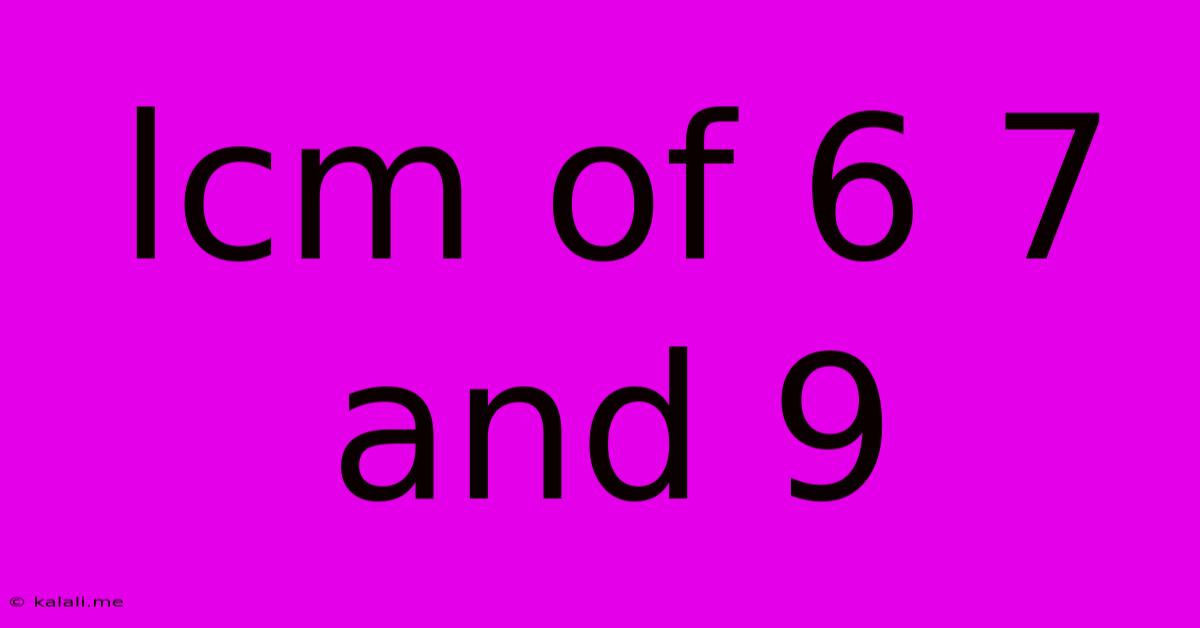Lcm Of 6 7 And 9
Kalali
Jun 14, 2025 · 2 min read

Table of Contents
Finding the LCM of 6, 7, and 9: A Step-by-Step Guide
Meta Description: Learn how to calculate the least common multiple (LCM) of 6, 7, and 9 easily. This guide provides a clear, step-by-step explanation with different methods, perfect for students and anyone needing to understand LCM calculations.
Finding the least common multiple (LCM) of numbers is a fundamental concept in mathematics, frequently used in various applications, from simplifying fractions to solving problems involving cycles and patterns. This article will guide you through the process of determining the LCM of 6, 7, and 9 using two common methods: prime factorization and listing multiples.
Understanding Least Common Multiple (LCM)
Before diving into the calculation, let's briefly define LCM. The least common multiple of two or more numbers is the smallest positive integer that is divisible by all the given numbers without leaving a remainder. For example, the LCM of 2 and 3 is 6, because 6 is the smallest number divisible by both 2 and 3.
Method 1: Prime Factorization
This method is generally considered the most efficient for finding the LCM of larger numbers. It involves breaking down each number into its prime factors.
-
Find the prime factorization of each number:
- 6 = 2 x 3
- 7 = 7 (7 is a prime number)
- 9 = 3 x 3 = 3²
-
Identify the highest power of each prime factor:
- The prime factors present are 2, 3, and 7.
- The highest power of 2 is 2¹ = 2
- The highest power of 3 is 3² = 9
- The highest power of 7 is 7¹ = 7
-
Multiply the highest powers together:
- LCM(6, 7, 9) = 2 x 3² x 7 = 2 x 9 x 7 = 126
Therefore, the least common multiple of 6, 7, and 9 is 126.
Method 2: Listing Multiples
This method is more straightforward for smaller numbers but can become cumbersome for larger ones.
-
List the multiples of each number:
- Multiples of 6: 6, 12, 18, 24, 30, 36, 42, 48, 54, 60, 66, 72, 78, 84, 90, 96, 102, 108, 114, 120, 126,...
- Multiples of 7: 7, 14, 21, 28, 35, 42, 49, 56, 63, 70, 77, 84, 91, 98, 105, 112, 119, 126,...
- Multiples of 9: 9, 18, 27, 36, 45, 54, 63, 72, 81, 90, 99, 108, 117, 126,...
-
Identify the smallest common multiple:
- Observe the lists above. The smallest number that appears in all three lists is 126.
Therefore, using the listing multiples method, we also find that the LCM(6, 7, 9) = 126.
Conclusion
Both methods effectively determine the LCM of 6, 7, and 9, yielding the same result: 126. The prime factorization method is generally preferred for its efficiency, especially when dealing with larger numbers or a greater number of values. Understanding both methods provides valuable tools for solving various mathematical problems involving LCM. Remember to practice regularly to master these techniques!
Latest Posts
Latest Posts
-
Electric Current Is Defined As The Flow Of
Jun 14, 2025
-
Which Of The Following Is A Primary Pollutant
Jun 14, 2025
-
Difference Between A Physical Map And A Political Map
Jun 14, 2025
-
Definition Of Normal Profit In Economics
Jun 14, 2025
-
Is 23 A Multiple Of 3
Jun 14, 2025
Related Post
Thank you for visiting our website which covers about Lcm Of 6 7 And 9 . We hope the information provided has been useful to you. Feel free to contact us if you have any questions or need further assistance. See you next time and don't miss to bookmark.